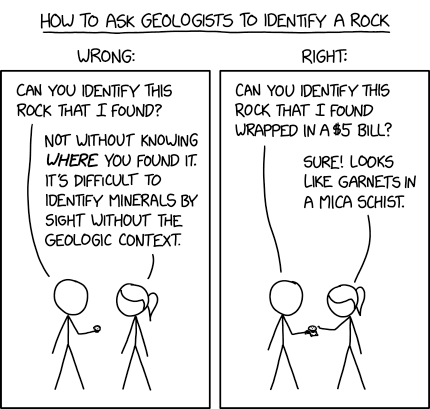Rock Identification
from negativenull@lemmy.world to science_memes@mander.xyz on 27 Mar 14:17
https://lemmy.world/post/27454265
from negativenull@lemmy.world to science_memes@mander.xyz on 27 Mar 14:17
https://lemmy.world/post/27454265
‘Is it worth anything?’ ‘I dunno, is the answer to that question worth another $5?’

threaded - newest
Scientists are people, too. Give them the McDonald’s money and they’ll do all sorts of cool things for you.
Slips a biologist $50 hey could you, like, get ahold of some multi drug resistant m. tuberculosis samples for me? thanks
Small price to pay for being like Arthur Morgan
Better method:
“Look at this cool agate I found!”
Where “agate” is substituted for any obviously incorrect identification.
Here in Kentucky, it’s likely either agate or coal. There isn’t much else.
this is why kentuckees have such great teeth, lots of coalgate
: Makes angry eye contact and points to door:
You have some ancient opal but very few people find it
I usually go with meteoric iron, that’s specific enough that they want to take a closer look
This approach does save $5.
Yo let me get a dime bag of that geology.
This can work. But:
"Look at this hand sample I found at a prospective mineral mining source. What sort of resources might we find here? I have included a hefty research grant."
Can confirm that the method on the right yeilds better results for anyone who asks me.
Jesus Christ, Marie. It’s a mineral!
I usually just say something like “look over there!” and sneakily replace the rock they were tasting to the one I want identified
I bet you warn about Land Wars in Asia, don’t you?
I’ve spent the last two years building up an immunity to garnets in a mica schist.
…tasting? 🤔
Rocks have distinct textures on the tongue that helps differentiate them. It’s not really tasting
h-hey you’re a geologist right? can you uh, identify this c- i mean… rock? for me?
Believe it or not, this is a legit thing. I haven’t done anything much with rocks*, but here’s a good example for soil. If it’s fine grained (smaller than sand) and you can’t see the particles by eye, you can rub some on your teeth:
Buttery texture --> clay Gritty on the teeth --> silt
Not approved for use on contaminated ground!
The book “Assembling California” by McPhee gives a lot of excellent description about context when it comes to geology. Gets a bit academic at times, but interesting background on California’s crazy geology.
They did not lick it. I don’t trust that expertise
At the small college I attended, Geology 101 was known as “Rocks for Jocks” because it was the class jocks took to satisfy their science requirement. In one hallway was a big display board with a bunch of labeled rock samples on it. If you memorized all of them well enough to identify them on the final, you were almost guaranteed to pass. So there were always football jocks standing there studying that board.
Yeah! Science!
Speaking of this, my wife has a dark gray rock about the size of a silver dollar she found many years ago in our front yard, within a mile of the shore of Puget Sound. It’s broken, with a reflective crystalline-looking structure inside, and a magnet attracts it. Anybody know how likely it is to be meteoric iron?
Sure as soon as the paypal payment goes through I’ll let you know.
Edit: I was wrong, see below! Shouldn’t have assumed simulating active galactic nuclei would make me knowledgeable about asteroids.
Astrophysicist, not a geologist here. Maybe if you sent a pic I might recognize it. But it’s kind of unlikely, since afaik crystals from under great pressures, which meteorites don’t tend to undergo like that.
Not only under pressure but under very slow cooling as what happens in the centers of asteroids
The rhomboid crystal structure of meteor iron was set long before that particular rock entered our atmosphere and is visible in many, MANY museum pieces.
I worked in the mining industry for awhile, and we’d just ask the geo to lick the rock to identify it.
I wish I had some geologist friends.